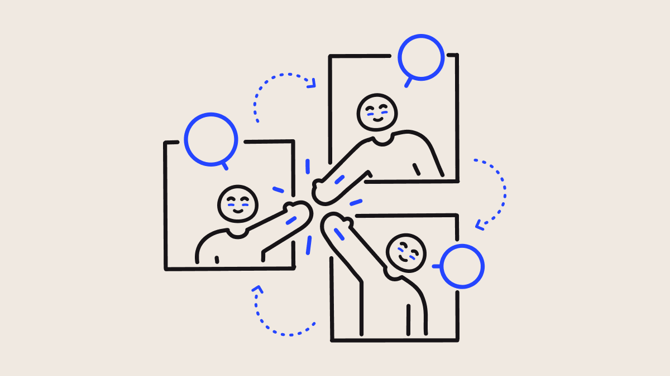Part of a manager’s job is to keep employee engagement high — and there are many ways to do that. From nurturing feedback loops to making employee experiences more personalized, engagement strategies help sustain productivity levels.
Research points to employee engagement as one of the most impactful engagement tactics. Our stats roundup reveals employees who feel recognized are 4X more engaged than those who don’t.
Meaningful recognition helps keep team morale up, fosters connection and offers direction to employees by validating the efforts that contribute the most to success.
So, how can managers provide adequate recognition when many employees now work in remote or hybrid settings? Today, employee recognition tactics require a bit of creativity. You’re in the right place — this article has a few tricks and tips to help you build a lasting and impactful culture of recognition at work!
Assess your organization’s employee experience in minutes

What's in this article
Why remote employee recognition is important — especially today
Employee recognition increases engagement and productivity and helps build a positive company culture. The impacts of remote employee recognition include:
- Encouragement and support through remote challenges: Virtual recognition helps balance out negative emotions that can occur throughout the day. Just because you can’t see an employee across a physical desk doesn’t mean they aren’t facing difficulties and pressures across a screen. Recognition is a great way to show support and keep human moments going, even if we’re not there in person.
- Increased employee engagement: Employee engagement increases when teams feel valued. Making recognition a habit increases their productivity and motivation — whether it’s a small acknowledgment or a more significant moment of recognition of good work done.
Improved employee retention: Happy employees, happy work life. Recognition immensely impacts retention — organizations prioritizing employee appreciation have a more loyal workforce and advocate for their employer.
Recognizing employees: Do the same rules apply remotely vs in the office?
The fundamental recognition principles apply to all employees, regardless of work setting. That said, nuances must be considered when recognizing remote employees — the lack of face-to-face interaction calls for a more deliberate and structured approach.
Managers need to be more proactive in seeking out opportunities to create moments of recognition remotely despite the distance.
The 4 types of recognition — and how they apply to remote work
Four types of employee recognition exist: public, private, monetary, and promotional. Recognition can come from managers and direct supervisors (top-down) or peers. Here are some examples that can apply to remote or hybrid contexts:
Public recognition
Public recognition involves acknowledging an employee's achievements or contributions publicly.
In a remote work context, this could be:
- During a virtual team meeting
- Via company-wide email
- In a peer-shared Slack channel
Private recognition
As the name describes it, private recognition takes place through one-on-one conversations. This type of recognition is more personalized.
In a remote work context, this could be:
- During a manager-employee meeting
- Via a peer-to-peer recognition platform
- Through a private feedback report
Monetary recognition
Monetary recognition includes tangible rewards. Think of financial incentives with a calculable monetary value attached to them.
In a remote work context, this could be in the form of:
- Salary bumps
- End-of-year bonuses
- Virtual gift cards
Promotional recognition
Promotional recognition, also called rewards, involves providing other opportunities as a form of recognition for exceptional performance.
In a remote work context, this could look like:
- Career advancement opportunities
- New responsibilities
- Specialized e-training
Different employees respond better to different types of recognition — some employees may really value the opportunity to be praised in front of their peers. In contrast, others may view private acknowledgment as more personal and meaningful.
Managers need to determine which types of recognition are the most impactful for each team member to ensure their recognition efforts are well-received and have the desired effect.
What other kinds of recognition do employees value the most?
Within the four main pillars of recognition exist variants of recognition messages. Generally, recognition is a positive acknowledgment or praise, formal or informal. But recognition doesn’t only come from managers — it can come from peers, too.
What is positive recognition for job performance?
Positive recognition for job performance is about acknowledging and appreciating an employee's efforts or contributions. Written or verbal (or even attached with some rewards), the point of positive recognition is that it reinforces desired behaviors.
What is an example of formal recognition?
Formal recognition is typically part of structured recognition initiatives — annual awards, employee of the month programs, or performance-based bonus schemes. Think of formal recognition as a systematic approach to appreciating employees.
What is an example of peep-to-peer recognition?
Peer-to-peer recognition builds camaraderie between team members, where colleagues acknowledge and show appreciation to one another, be it Slack channel shout-outs, thank-you notes, or nominating them for internal awards.
By getting everyone involved in fostering a culture of appreciation, you’re ultimately setting up remote employees with more opportunities to connect and feel seen.
8 remote employee recognition ideas to keep your team engaged from home
You may have scrolled right to this part of the article — and we don’t blame you. Remote managers need to get creative when it comes to building their team's engagement and morale across a screen.
Here are some key employee recognition ideas for you to put into action:
1. Don’t wait for formal opportunities: Give an employee kudos every day
Employee recognition doesn’t have to be turned into a big deal for it to mean a great deal — even a small kudos can make someone’s day. Managers and peers should be generous with showing appreciation, especially in a remote setting where human moments don’t occur as frequently.
Share a remote employee kudos via:
- Personalized private messages
- Slack shoutouts
- In a virtual team meeting
Not sure how to phrase a kudos? Personalize this script:
Thank you, [Team member name], for your [help, positive attitude, support, ideas, or other]. Thanks to your contribution, [describe impact]. Make sure to pass on kudos to someone else on the team who has impacted you this week!
2. Begin and end virtual meetings with moments of recognition
Like the sandwich method, managers should try to begin and end every one-on-one meeting with moments of recognition — whether about performance or simply attitude. Not only does this set a positive tone for any discussions planned in that meeting, but it also ensures the meeting ends on a motivating note.
Meeting-appropriate recognition can also look like:
- One-on-one acknowledgment from a manager
- Team appreciation during a weekly status
- Round table recognition by peers
The following question should help you reflect on what to praise:
- How has this person influenced good outcomes?
- Has this person’s work, attitude, or actions supported our remote team?
- Has this person exceeded expectations? If so, how?
3. Make virtual recognition a team effort
Managers support their teams. That said, colleagues support one another too. While formal recognition from a superior has a lot of value, so does informal recognition from peers. It’s important to encourage everyone to show praise.
Virtual team recognition ideas:
- Direct peer-to-peer recognition via chat channels
- Virtual recognition wall or board
- Team building activities
4. PDA: Recognize team members cross-team and company-wide
Great leaders don't take all the credit — they share it. By sharing recognition publicly, managers demonstrate that they value their employee’s collective contribution. This is also another way to lead a positive company culture by example.
PDA (public displays of appreciation) remotely can be:
- Public acknowledgment at meetings online
- Employee of the month programs
- Employee appreciation virtual events
Pass the mic to others who have contributed!
Invite other employees to chime in and recognize one another during those public moments. Recognizing effort and good work builds team morale, confidence, and job satisfaction big time — so leverage more voices!
5. Address remote work directly and point out what's going well
Not everyone has the same ease with remote work, so even acknowledging good performance within remote contexts can keep morale going. Managers should point out what’s going well, specific to remote work.
Noteworthy things to acknowledge for remote employees:
- Team collaboration across time zones
- Remote or asynchronous communication
- Support for one another even from afar
Invite employees to share remote work solutions
Who better to share hot tips and insights on improving remote work than those directly in it? Managers can gain insights and increase employee engagement by asking teammates to share remote work productivity hacks.
6. Leverage virtual experiences and get creative
Thanks to the boom of remote and hybrid work in recent years, thousands of new software solutions specifically made to enhance the virtual office experience have hit the market. But managers and employees can also think outside the box in showing recognition efforts.
Some ideas to consider:
- Interactive chat integrations with GIFs
- Monthly recognition emails or newsletters
- Care packages sent to home offices
Running out of ideas? Ask employees for their fresh take!
If you need new ideas to level up recognition tactics, get inspired by employee suggestions. Pulse surveys are a great way to get a virtual “ideas box” going.
7. Celebrate milestones together, even from afar
Even remotely, employees celebrate big milestones such as work anniversaries or the end of big projects. Real life continues to happen even behind a screen — it’s important for managers not to forget about celebrations.
Things to celebrate, even in remote settings:
- Team celebrations on project completion
- Recognition badges or certificates
- Work anniversary celebrations
You can have your remote cake and eat it, too.
For significant milestones like work anniversaries, remote employees can:
- Chip in for a cake or meaningful gift sent by post
- Sign a virtual card using a collaboration platform like Miro
- Book out an hour in the day for a virtual break to celebrate together
8. Consider remote rewards
Words are great, but who can say no to a reward? Everybody appreciates a tangible token of appreciation — and they should still be a central part of recognition strategies, even in remote work contexts:
Rewards that work for remote employees:
- Flexible work options
- Digital gift cards or vouchers
- Spot awards celebrated on Zoom
- Creative awards or trophies sent by mail
Biggest reward? Professional development opportunities!
One of the most gratifying rewards for employees comes in the form of career advancement. Professional opportunities are a way to incentivize employees to keep performing at their best and are a key driver for sustained engagement.
6 tips for making remote recognition effective and meaningful
Mastering remote recognition is essential for keeping your team motivated and engaged. Here, we’ve listed six expert tips to ensure your recognition efforts hit the mark — no matter where your employees work.
1. Ask remote workers how they want to be recognized
In a remote work environment, individual employees may have different preferences for how they like to be recognized. Rather than play guessing games, managers should take the time to learn individual preferences and directly ask each employee what works for them.
Here are some useful questions to spark the conversation (either through a one-on-one conversation or via a pulse survey):
- What kind of recognition is most meaningful to you?
- How do you prefer to receive recognition: publicly or privately?
- Do you prefer verbal recognition, written acknowledgment, or tangible rewards?
- How do you define meaningful recognition in the context of remote work?
- Are there any past instances of recognition that stood out to you as particularly impactful?
- Do you have any suggestions or ideas for improving or making recognition more meaningful in our remote work environment?
- Is there anything else you would like to share about your preferences regarding recognition?
2. Make recognition authentic and from the heart
While gift cards and monetary rewards have their place, personal and sincere feedback often leaves a lasting impression. Instead of relying solely on material rewards, managers should also offer verbal or written feedback that explicitly acknowledges an individual's contributions (and their positive impact).
In fact, a Deloitte survey shows that 54% of employees prefer to be recognized with a “Thank you” message, compared to 7% who would prefer a gift.
Here are some messages of recognition templates to inspire you:
- Specific feedback: "John, I wanted to express my gratitude for your exceptional work on the recent project. Your attention to detail and ability to meet tight deadlines significantly impacted our team's success. Thank you for going above and beyond to ensure its completion."
- Personalized recognition: "Sarah, I want to take a moment to recognize your dedication and creativity in handling the client's request last week. Your innovative approach solved the problem efficiently and impressed the entire team. Your contributions are truly valued and make a difference."
Genuine appreciation: "David, I just wanted to say thank you for your consistent positivity and willingness to help out whenever needed. Your enthusiasm is contagious; working with someone who always brings their best to the team has been a pleasure. Your efforts don't go unnoticed, and I appreciate everything you do."
3. Encourage team member recognition across the board
Recognition isn't limited to a top-down approach. Colleagues, managers, and executives alike benefit from it. Promote peer-to-peer recognition across the hierarchy. By fostering a culture where everyone acknowledges each other's contributions, everyone helps create a positive and supportive work environment.
How to encourage team member recognition at every level:
- Foster a culture of appreciation where everyone feels empowered to recognize their colleagues and incorporate this in onboarding programs.
- Provide platforms or channels for peer-to-peer recognition, such as dedicated Slack channels or moments during team meetings.
- Lead by example by openly acknowledging and appreciating the efforts of your team members at all levels.
- Celebrate successes and milestones collectively as a team, reinforcing a sense of unity and camaraderie, where higher-ups are invited.
4. Offer staff recognition to individuals who work behind the scenes
A lot goes into a project. Managers need to remember to recognize those who work behind the scenes or indirectly contribute in valuable ways.
Managers should also encourage team members to highlight the achievements of those whose work goes unnoticed. Not only does this help develop leadership skills among team members, but it also fosters empathy and camaraderie within the team.
Ways to recognize employees working behind the scenes:
- Acknowledge the efforts of support staff, remote administrators, or those working on the infrastructure that enables others to excel, like tech support.
- Encourage team members to express gratitude for their colleagues' less visible but equally valuable contributions.
- Incorporate recognition of behind-the-scenes work into regular team meetings or virtual gatherings to ensure visibility and appreciation.
5. Incorporate remote employee recognition program surveys in your feedback system
Managers can leverage feedback mechanisms to gauge recognition frequency and quality. By implementing ways to understand how employees are feeling and what they need from you, you’ll be able to adjust your performance management approach at need.
Additional ways to collect recognition insights from employees:
- Incorporate brainstorming sessions with the team to address any low engagement metrics revealed in the surveys. Tap into the collective intelligence of your team to find solutions.
- Implement regular surveys or feedback mechanisms specifically focused on recognition and appreciation.
- Use anonymous feedback tools to encourage honest responses and gather insights into the effectiveness of recognition efforts.
- Utilize a visual team engagement report to get a quick overview of your team's happiness levels and identify areas for improvement.
- Use AI to analyze survey results to identify trends, areas of improvement, and opportunities to enhance the recognition culture within the organization.
6. Keep recognition efforts regular — consistency is key!
Whether it's a daily shout-out or a monthly recognition event, keeping these efforts consistent fosters a culture of appreciation and motivates employees to continue delivering their best. Hey, there’s no shame in setting calendar reminders, too!
Tips to help everyone make recognition a habit:
- Establish a schedule for recognition activities, whether a weekly shout-out during team meetings or a monthly awards ceremony.
- Integrate recognition into everyday interactions and communications rather than saving it for special occasions.
- Use technology tools like recognition platforms or apps to automate and streamline the process of acknowledging achievements.
- Encourage managers and team members to incorporate recognition into their daily routines, making it a natural part of the work culture.
- Provide training and guidance on effective recognition practices to ensure all employees understand the importance of consistent feedback and appreciation.
Enhancing moments of recognition for employees near and far
In a remote work dynamic where trust and autonomy are heavily relied upon, sustaining high levels of motivation and engagement is non-negotiable.
However, cultivating a culture of appreciation requires consistent effort and attention — and the modern manager needs to adapt the virtual experience to make recognition moments as human and impactful as possible. This is where technology designed specifically for employee recognition can make a difference.
By leveraging software to gather valuable insights directly from their team and understanding their sentiments and managerial needs, managers can adjust their recognition efforts to fit the bill.
Creating a culture of appreciation and value is just the beginning — and the necessary foundation for creativity and innovation. By keeping remote teams connected through day-to-day recognition efforts, you’ll be one step closer to a connected workforce motivated to give its all.
Hungry for more recognition insights? Download Officevibe's recognition guide for more best practices on appreciating your team.
Equip HR and managers with tools to engage, recognize, and drive performance.




